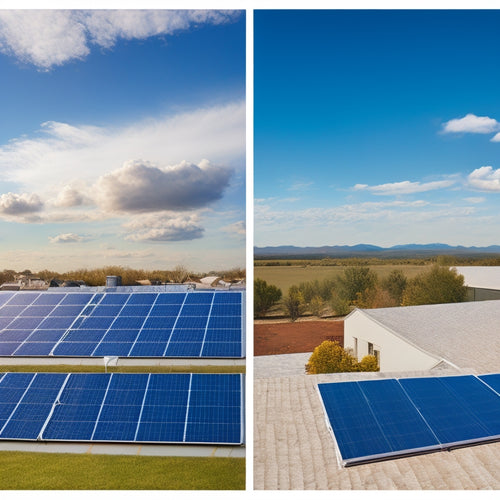
Cost of a Solar Battery Backup System Installation
Share
You're likely to pay between $15,000 and $30,000 or more for a solar battery backup system installation, depending on the system's size, type, and features. Labor costs, which range from $2,000 to $5,000, are influenced by the system's complexity and local labor markets. The type of battery you choose, such as lithium-ion or lead-acid, also affects the overall cost. Other factors, including installation site and permit fees, monitoring and maintenance expenses, and federal and state incentives, can further impact the total installation cost. As you consider your options, you'll want to weigh these factors to guarantee you get the right system for your needs.
Key Takeaways
- The total installation cost of a solar battery backup system ranges from $15,000 to $30,000 or more, depending on system size and complexity.
- Labor costs, which include installation, electrical, and plumbing work, range from $2,000 to $5,000, depending on the location and system requirements.
- The cost of solar panels, charge controllers, battery banks, inverters, and monitoring systems vary, with lithium-ion batteries being the most expensive option.
- Federal and state incentives, such as the Solar Investment Tax Credit (ITC), can reduce the installation cost by up to 26%, making the system more affordable.
- Ongoing maintenance and monitoring expenses, including scheduled checks and software updates, are necessary to ensure optimal system performance and extend its lifespan.
System Components and Their Costs
A solar battery backup installation consists of several key components, each contributing to the overall cost of the system.
You'll need solar panels, which convert sunlight into electrical energy, and a charge controller, which regulates the flow of energy to your battery bank.
The battery bank itself is a vital component, as it stores excess energy generated during the day for use at night or during power outages. The type and quality of batteries you choose will impact your battery lifespan, with higher-quality options lasting up to 15 years or more.
An inverter/charger is also essential, as it converts DC power from your solar panels and battery bank to AC power for your home.
You'll also need a monitoring system to track your energy production and consumption, ensuring you're getting the most out of your system.
Finally, you'll need a mounting system for your solar panels and an electrical panel to connect your system to your home's electrical infrastructure.
Installation Labor Costs Breakdown
With your solar battery backup system components in place, it's time to reflect on the labor costs associated with installation. You'll need to take into account the proficiency and time required to install your system correctly.
The labor market for solar battery backup system installers can vary depending on your location and the complexity of your system. On average, installation labor costs can range from $2,000 to $5,000 or more, depending on the size and complexity of your system.
These costs typically include installation training and certification, guaranteeing that your system is installed correctly and safely. You may also need to factor in additional labor costs for electrical and plumbing work, as well as any necessary permits or inspections.
When evaluating installation labor costs, look for companies with experienced technicians who've received proper installation training. This will make certain that your system is installed efficiently and effectively, minimizing the risk of errors or safety hazards.
Factors Affecting Total Installation Cost
When you're considering a solar battery backup installation, you'll need to account for various factors that impact the total installation cost.
The size and type of system you choose will greatly influence the final price, as larger systems or those with advanced features tend to be more expensive.
Additionally, the complexity of the installation, including any necessary electrical upgrades or custom configurations, will also affect the overall cost.
System Size and Type
Your solar battery backup system's size and type considerably impact the total installation cost. The system size you need depends on your energy requirements during a power outage. You'll need to evaluate the number and type of appliances you want to power, as well as their energy consumption. A larger system will naturally cost more, but it will also provide more power and longer backup times.
Sizing considerations are critical to ascertain your system can meet your energy needs. You'll need to determine the total wattage of the appliances you want to power and the number of hours you want to power them. A system that's too small won't provide enough power, while one that's too large will be inefficient and waste energy.
System efficiency is also a key factor, as a more efficient system will provide more power per unit of energy stored.
The type of system you choose also affects the cost. For example, a lithium-ion battery system will typically be more expensive than a lead-acid battery system, but it will also be more efficient and have a longer lifespan.
Installation Complexity
Incorporating a solar battery backup system into your home's electrical infrastructure can be a complex process, requiring careful planning and execution to guarantee a safe and efficient installation.
You'll need to take into account various installation challenges that can impact the total cost of the project.
One significant factor is equipment accessibility. If your home has a complex roofline or limited space for equipment, installation may require additional labor and materials, increasing costs.
Additionally, if your electrical panel is outdated or undersized, you may need to upgrade it to accommodate the solar battery backup system, adding to the overall expense.
In addition, the complexity of your home's electrical infrastructure can also affect installation costs.
For instance, if you have a multi-story home or a large, sprawling property, running cables and connecting equipment can be more complicated, requiring more time and resources.
Moreover, local building codes and permits may also impact installation complexity, leading to higher costs.
Battery Type and Cost Comparison
You'll need to contemplate the type of battery that best suits your solar backup system, as it greatly impacts the overall cost.
Lithium-ion batteries, known for their high energy density and long lifespan, come at a premium price.
In contrast, deep cycle batteries offer a more affordable option, but may require more maintenance and replacements over time.
Lithium-Ion Battery Costs
Among the various solar battery backup options available, lithium-ion batteries have emerged as a popular choice, thanks to their high energy density, long lifespan, and relatively low maintenance requirements.
You're likely drawn to their benefits, but what about the cost?
When evaluating lithium-ion batteries, you'll notice they're generally more expensive than other types. However, their advantages make them a worthwhile investment for many homeowners.
Here are some key factors to evaluate:
- Lithium-ion batteries typically cost between $7,000 and $15,000, depending on the capacity and quality of the system.
- They've a longer battery lifespan, typically lasting 10-15 years or more, which reduces replacement costs over time.
- Their high energy density means they take up less space, making them ideal for homes with limited area.
- Lithium-ion batteries have a lower environmental impact due to their recyclable materials and reduced waste.
- They often come with advanced features like built-in inverters and monitoring systems, which can enhance overall system performance.
Keep in mind that while the initial cost may seem high, lithium-ion batteries can provide long-term savings and benefits that make them a worthwhile investment for your solar battery backup system.
Deep Cycle Battery Options
Beyond lithium-ion batteries, deep cycle batteries offer an alternative solution for solar battery backup systems. You may consider them if you're looking for a more affordable option.
Deep cycle batteries are designed to provide a steady flow of energy over a longer period, making them suitable for off-grid solar systems or backup power applications.
When it comes to deep cycle batteries, you'll find two main types: flooded lead-acid and sealed lead-acid (also known as maintenance-free or valve-regulated lead-acid).
Flooded lead-acid batteries are the most cost-effective option, but they require regular maintenance to guarantee peak performance. Sealed lead-acid batteries, on the other hand, are more expensive but offer a maintenance-free design.
In terms of cost, deep cycle batteries are generally priced lower than lithium-ion batteries. However, their battery lifespan and charging cycles are shorter.
You can expect a flooded lead-acid battery to last around 5-7 years, with 200-300 charging cycles, while a sealed lead-acid battery can last up to 10 years, with 400-500 charging cycles.
When choosing a deep cycle battery, consider your energy needs and the overall cost of ownership, including maintenance and replacement costs.
Inverter Cost and Efficiency Impact
The inverter is an essential component of a solar battery backup system, as it converts DC power from the solar panels and battery bank to AC power for your home.
You'll want to choose an inverter that provides high efficiency, a long lifespan, and compatibility with your system.
Some key factors to take into account when selecting an inverter include:
-
Inverter efficiency: Look for an inverter with a high efficiency rating (e.g., 95% or higher) to minimize energy losses.
-
Inverter lifespan: A longer lifespan (e.g., 10-15 years or more) means fewer replacement costs and less waste.
-
Inverter brands: Research reputable brands like Schneider, SMA, and Tesla to verify you're getting a high-quality product.
-
Inverter warranties: A detailed warranty (e.g., 5-10 years) provides peace of mind and protects your investment.
-
Inverter upgrades: Ponder an inverter with upgradeable firmware to future-proof your system.
Installation Site and Permit Fees
You'll need to evaluate the installation site and permit fees when calculating the total cost of your solar battery backup system. A thorough site evaluation is essential to determine the system's configuration, size, and installation requirements. This process involves reviewing your property's energy usage patterns, available roof or ground space, and local building codes.
The site evaluation will also identify potential obstacles, such as shading issues or structural limitations, that may impact the system's performance.
The permit requirements will vary depending on your location and local authorities. You'll need to obtain necessary permits from your utility company, city, and county before commencing the installation.
Permit fees can range from a few hundred to several thousand dollars, depending on the complexity of the project and local regulations. Be sure to factor these costs into your overall budget to avoid surprises.
A reputable installer will handle the permit process on your behalf, ensuring compliance with local regulations and minimizing potential delays. By considering the installation site and permit fees, you'll get a more accurate estimate of your solar battery backup system's total cost.
Monitoring and Maintenance Expenses
As your solar battery backup system becomes operational, ongoing monitoring and maintenance expenses will secure it runs at peak performance and extends its lifespan.
Regular monitoring allows you to identify potential issues before they become major problems, guaranteeing your system operates efficiently and effectively.
To promote optimal performance, you'll need to budget for the following monitoring and maintenance expenses:
-
Monitoring technologies: Invest in advanced monitoring systems that track your system's performance, alerting you to any issues or malfunctions.
-
Maintenance schedules: Regularly scheduled maintenance checks will help identify and address potential problems before they impact your system's performance.
-
Battery maintenance: Proper maintenance of your batteries is vital to extending their lifespan and promoting optimal performance.
-
Software updates: Regular software updates will guarantee your system remains compatible with the latest technologies and runs efficiently.
-
Emergency repairs: Budget for unexpected repairs or replacements to minimize downtime and guarantee your system is always operational.
Federal and State Incentives Impact
Government-backed incentives can greatly offset the cost of solar battery backup installation, making it more affordable for homeowners and businesses. You can take advantage of federal incentives, such as the Solar Investment Tax Credit (ITC), which allows you to claim a tax credit of 26% of the total system cost.
Additionally, many states offer rebates and tax credits that can further reduce your expenses. These incentives not only provide substantial energy savings but also contribute to environmental benefits by promoting renewable energy.
When considering system financing, you should factor in these incentives, as they can greatly impact your long-term investment. Keep in mind that policy changes can affect the availability and scope of these incentives, so it's important to stay updated on current regulations.
Frequently Asked Questions
Can I Install a Solar Battery Backup System Myself?
You can attempt a DIY installation, but be aware that solar battery backup systems involve complex electrical connections and safety considerations; it's recommended you hire a licensed professional to guarantee a safe and efficient installation.
How Long Does a Typical Installation Take to Complete?
As you commence on this energy quest, you'll find that a typical installation takes around 1-3 days, depending on the installation timeline and factors like system size, roof complexity, and permits, which can speed up or slow down the process.
Are Solar Battery Backup Systems Compatible With All Roofs?
You'll find that solar battery backup systems are compatible with most roof types, but you'll need to verify your roof meets specific installation requirements, such as structural integrity and adequate space for the system's components.
Can I Add a Solar Battery Backup to an Existing Solar Panel System?
You can add a solar battery backup to your existing solar panel system, achieving seamless solar panel integration and increased energy independence, as long as your existing system meets the necessary electrical and infrastructure requirements.
Will a Solar Battery Backup System Increase My Property Value?
As you inject a shot of adrenaline into your home's energy setup, you'll find that a solar battery backup system is a golden thread that weaves together increased property value and long-term investment benefits, making your home a more attractive and sustainable haven.
Related Posts
-

Why Nearby EV Conversion Shops Matter to You
Having a nearby EV conversion shop means you'll experience the benefits of a more personalized, convenient, and susta...
-

What You Need to Know About RV Solar Maintenance
When you're out on the road, your RV's solar panel system is your lifeline. But without regular maintenance, you're l...
-

Tracking Solar Panels Vs Fixed Panels Cost Savings
When considering solar panel options, you'll want to weigh the cost savings of tracking solar panels versus fixed pan...


